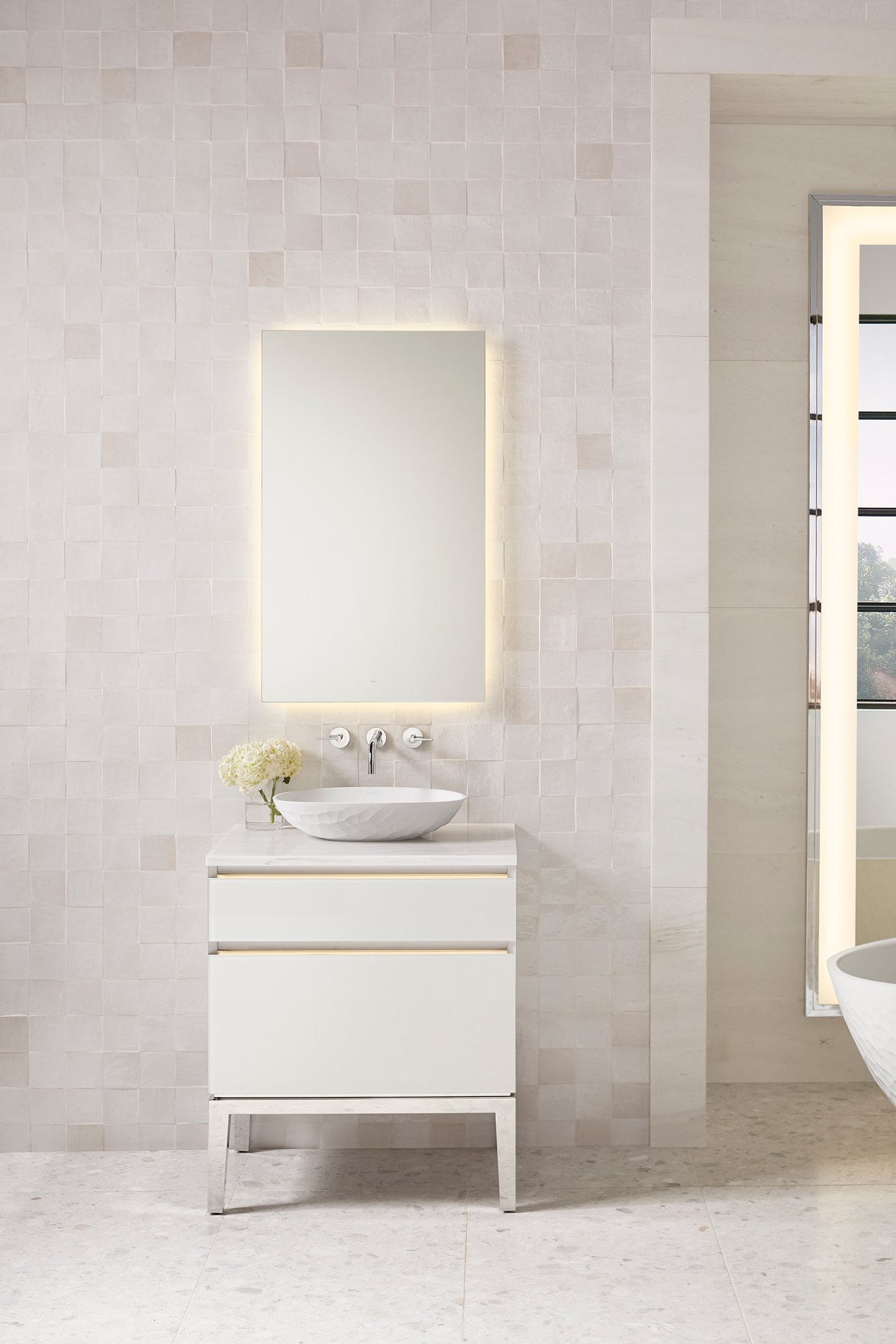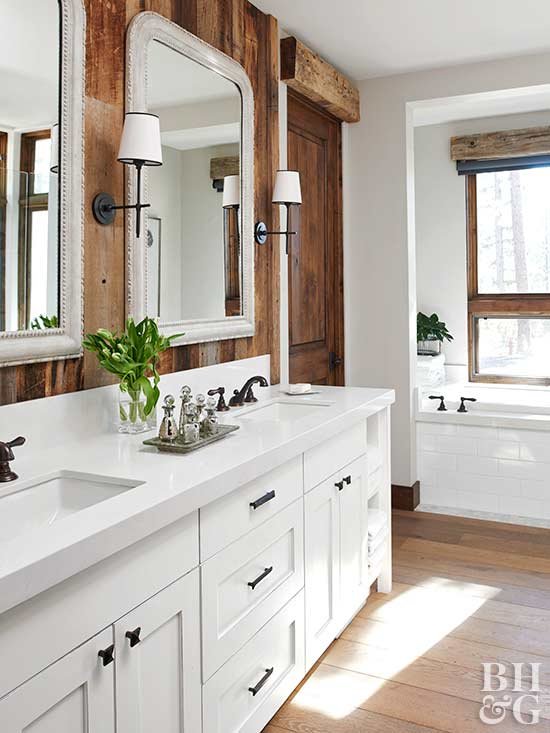
2021 Bathroom Design Trends That Will Be Huge Next Year
With 2020 came sheltering in place and, with it, a heightened awareness of the cleanliness of our homes. As hygiene continues to be top of mind, particularly in high-traffic environments like bathrooms, expect interiors that prioritize easy-to-clean surfaces and antimicrobial fixtures. Luckily, 2021 bath trends include these items without sacrificing an ounce of style. 
1. Floating Vanities
Although the crisp lines of floating vanities typically lean contemporary, the space-saving storage solution has more customization options than ever before, with sinks, faucets, and hardware to fit any style. Wall-mount bathroom vanities come in an array of configurations, from a complete unit with a countertop, sink and storage base-like a freestanding vanity without the legs-to partial sets and entirely separate pieces.
The latter option lets you find the ideal arrangement-such as the width and length of the countertop, or the type and location of storage-without limiting it to the space available around the plumbing. “You can use storage cabinets on the wall vertically or horizontally, open or closed, higher or lower,” says Bob Gifford, director of business development for Hastings Tile & Bath. “A wall-hung vanity is clean and airy and doesn’t seem like a big heavy box on the floor." And regardless of its setup, floating vanities make it easier to clean bathroom floors, too.

2. Large-Format Wall Tiles
Say farewell to tiny mosaic tiles in 2021-at least when it comes to bathroom walls. “The movement toward larger format tiles will gain momentum in the coming year as this style can make a big impact on a space while displaying fewer grout lines,” says Suzanne Zurfluh, director of design and trend at Emser Tile. Large-format tiles lend an air of luxury, particularly when paired with natural stone and stone-look materials. Fewer grout lines also mean less to clean, making slabs an especially hot choice for shower surrounds.
In addition to large tiles and slab wall coverings, nontraditional subway tiles offered in various sizes, colors, textures, and finishes will be a big 2021 bathroom design trend, says Zurfluh. Specifically, expect to see vertically and horizontally stacked linear tiles for their fashionable minimalist appearance.
These simple installations also complement the tile colors we expect to see this year. “Warm, inviting neutrals and earthy hues such as beige, tan, brown and mushroom shades will gain popularity as they provide an ideal setting for authentic materials,” says Zurfluh.
3. Back-Lit Mirrors and Medicine Cabinets
According to Houzz, three out of four homeowners (77%) install new mirrors during a master bathroom renovation, and most are now choosing lighted models. “Backlit mirrors and medicine cabinets are an exceptional choice for modern bathroom design,” says Linda Lang, senior staff designer at Robern. This embedded feature offers ambient lighting without added glare or reflections on the mirror and can double as a nightlight when dimmed.
These simple shapes with eye-catching lighting can be decorative as well as functional, too. “A backlit mirror creates a glowing effect on the wall giving the illusion of a floating mirror,” says Lang. This effect can be used to create a focal point or highlight textured wall surfaces behind the fixture.

4. Space-Savvy Soaking Tubs
The pandemic has only increased homeowners' desire for rest and relaxation, making soaking tubs a top bathroom feature for the year ahead. According to a Houzz bathroom trends study, freestanding, flat-bottom tubs will be more popular than clawfoot models or more decorative bases. Kim Frechette, national sales manager for Americh, says these simple tub silhouettes, especially in white, work well in any style of bath.
A separate tub and shower is still the most popular bath layout, and showers continue to get larger. But according to Frechette, tubs are not being lost in the shuffle. Instead, they’re doing more in less space-with some very tangible benefits. “A smaller-size bath doesn’t require as much time to fill or need as much water,” she says.
5. Warm Colors and Durable Paint
A fresh coat of paint in a new hue goes a long way to freshening up and starting anew after a long year, especially in a bathroom. The top colors for 2021 are vibrant and warm, an ideal mix for the room that both starts and ends your day.
Regardless of the color you choose, look for new durable paints to help your bathroom stay cleaner for longer. 2020 saw many advancements in making paints more hygienic, stain-resistant, and able to withstand pandemic-motivated cleaning. “PPG UltraLast paint + primer is specifically formulated to resist mildew on the paint film, so it can be used in moist interior environments like bathrooms and kitchens with confidence,” says Joanne Currie, Senior Portfolio Manager for PPG Paints. These advancements have also made it possible for hard-wearing paints like UltraLast to come in multiple finishes, “So that customers no longer need to compromise on the look they want to get more washability,” Currie says.

6. Quartz Countertops
“As one of the hardest natural materials, quartz is resistant to scratching and staining, and is also easy to maintain,” says Massimo Ballucchi, executive director of marketing for Cosentino Americas. So it's no surprise that quartz dominated all other materials in the NKBA 2021 bathroom trends report, in which 74% of designers picked it as the top countertop material for baths.
Ballucchi says quartz countertops like Silestone easily keep up with the frequent cleaning that’s part of the new normal. Plus, because quartz surfacing is non-porous, it is inherently less susceptible to fostering bacteria-an important trait in a damp environment. In line with today's contemporary-leaning bath designs, these countertops have sleek profiles with few seams, which also adds to their low-maintenance appeal.
Quartz countertops are strongly trending toward lighter finishes, reflecting the warmth anticipated in popular 2021 colors and the aesthetics gaining a foothold in bathrooms. “As we move into organic trends, we will soon see more mixing of elements, such as Silestone that imitates the look of marble or cement paired with natural wood,” says Ballucchi.
7. Smart Toilets
Once seen as a futuristic and costly luxury, smart toilets and bidets are finding a prominent place in the post-pandemic home, according to the NKBA 2021 design trends report. “Toilets have traditionally been a gross nuisance to clean, but there are several worthwhile advances in this category that make them easier and healthier to live with,” writes wellness design consultant Jamie Gold in her book Wellness by Design.
Smart toilets have hands-free components, like self-closing lids and touch-free flushing, which reduce interactions with germy surfaces. Another feature to look forward to is self-cleaning technology. “This includes bacteria-killing light under the lid, interior mechanisms that do the cleaning for you, and cling-free bowl surfaces,” writes Gold. Because they tend to favor clean lines, smooth surfaces and wall-mount installations, smart toilets eliminate the nooks and exposed plumbing of more traditional models, making cleaning the exterior easier, too.
8. Wood-Look Tiles and Heated Flooring
As the top-ranking materials for flooring in the NKBA report, porcelain and ceramic continue to be popular in bathrooms thanks to their versatility. “Ceramic and porcelain tile offer an array of unique benefits, such as durability, hypoallergenic characteristics, resistance to moisture and bacteria, easiness to maintain and clean, along with a wide assortment of stylish patterns, colors, and sizes to choose from,” says Zurfluh.
Expect to see ceramic and porcelain tiles that mimic natural hardwood finishes and high-contrast marbles, says Zurfluh. These nature-inspired looks are in line with the emerging organic style that has gained traction in both kitchens and baths this year. And for a spa-like touch, heated floors are anticipated to grow in popularity, so you can slip off your slippers in comfort.











